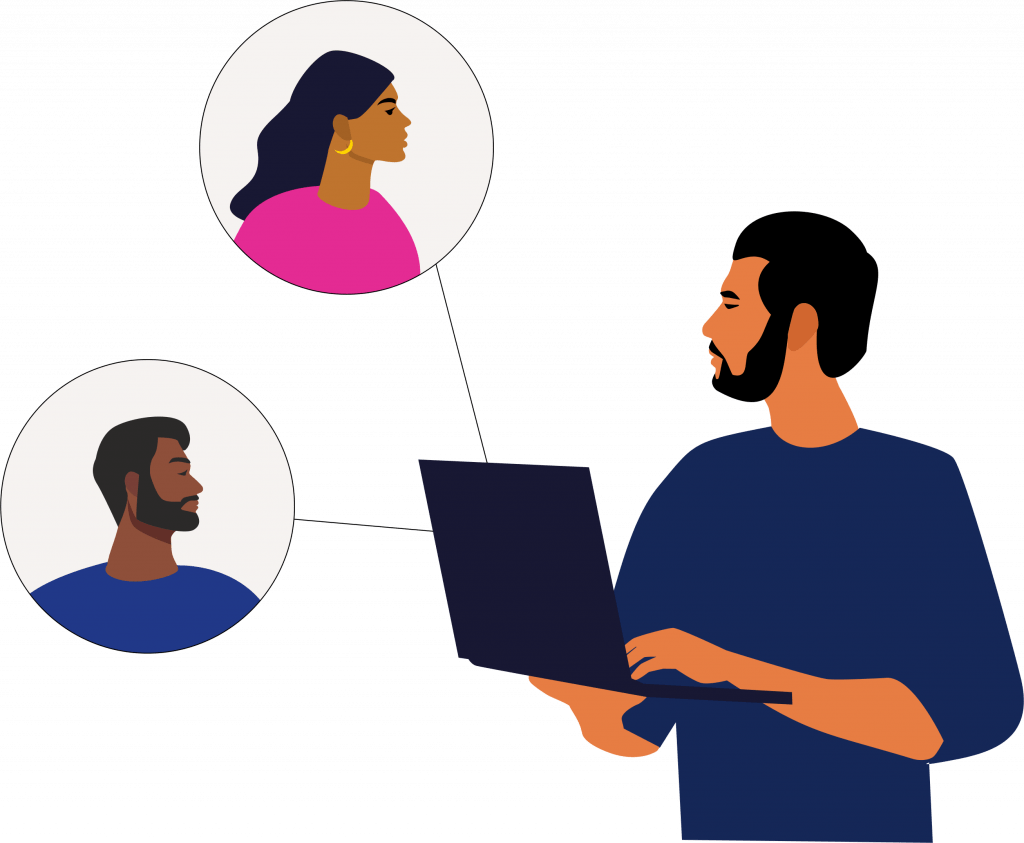Creative problem solving approach
Human-centered design (HCD) is a creative approach to problem-solving that starts with the people you’re designing for and ends with new solutions that are purpose-built to suit their needs and aspirations. It is based on putting all your assumptions aside, and truly listen and observe about people’s pain points or aspirations. You go beyond just noting what people say. You also try to dig deeper and understand how people feel, what they think and observe what they do.
HCD involves people in all stages of the design process to cultivate deep empathy with the people you’re designing for; generating new ideas; building a bunch of prototypes; sharing what you’ve made with the people you’re designing for; and eventually, putting your innovative new solution out in the world for testing and evaluating of the effectiveness of the outcome.
What HCD looks like in practice
HCD Process
To simplify, HCD is depicted as a linear process below. However, in practice, the process is carried out in a more flexible and non-linear fashion.

Read more
Identify problem areas
The first stage is to scope the problem areas you are trying to solve. This involves consulting colleagues and experts that you can easily and informally consult to find out more about the area of concern. This includes the identification of the stakeholders in the system, and banking on the background knowledge you already have on these stakeholders.
Formulate problem hypothesis
The background knowledge we have about the system, its stakeholders and the context in which the problems often occur will help us to formulate the various problem hypotheses. A well defined problem hypothesis should include contextual assumptions, description of user persona, user needs and problems and the underlying motivations to solve those user problems. This helps us to identify and prioritise the user segments and/or stakeholder segments to engage with in the Empathise phase.
Empathise with users
Once we have defined the initial problem hypothesis and identified the key stakeholder segments to focus on for solution development, we are now ready to move into the Empathy phase, which is the foundation of human-centered design. The problems you’re trying to solve are rarely your own, they’re those of particular users. Build empathy for your users by learning their values You’ll engage with and observe your target audience. The aim of this step is to paint a clear picture of who your customers/users are, what challenges they face, and which needs and expectations of theirs must be met. In order to build empathy, you’ll conduct surveys, empathy interviews and contextual observations. And the most challenging part in this phase is to adopt a beginners’ mindset by putting aside your assumptions and prejudices.
Here are three examples of activities you can do:
- Observe: view users and their behavior in the context of their lives.
- Engage: interact with and interview users through both scheduled and short ‘intercept’ encounters.
- Immerse: wear your users’ shoes. Experience what they experience for a mile or two.
Define opportunities
The define mode is when you unpack your findings from the empathise phase and translate them into user/stakeholder insights. These user insights are analysed to identify various patterns (behavioural, contextual, etc.) and to plot opportunity hotspots from which solution directions can be derived.
Based on your understanding about the users/user segments and their contexts, you can now refine the initial problem hypothesis by reframing it into an actionable statement known as ‘Design Challenge’.
The design challenge statement is a unique design vision that is framed from the perspective of a specific user/user segment. It clearly defines the specific problem of the target user/user segment that you will be addressing in the project. It will guide the entire project team from here on out, by providing a specific goal to focus on and by firmly placing the user/user segment at the center of the design process. Hence, a good design challenge statement will always be human-centric, broad enough to encourage creativity and yet specific enough to provide guidance and direction.
Idea generation
The goal of idea generation is to explore a wide solution space. With a clear design challenge developed, you’ll now aim to come up with as many ideas and potential solutions as possible. The ideation phase gets you thinking outside the box and exploring new angles. By focusing on the quantity and diversity of ideas versus the quality, you’re more likely to free your mind and stumble upon innovative solutions. During ideation sessions you’ll use a range of different ideation techniques such as brainstorming, reverse thinking the worst possible idea.
Prioritise promising ideas
With a wide range and variety of ideas at hand, you’ll now aim to select the most promising ideas to be conceptualised / prototyped and tested. Prioritising ideas and concepts can be done against many criteria, but should involve the perspective of the customers/users derived from the research insights. Prioritising by factoring levels of desirability, feasibility, viability and impact an idea can have, is a good place to start with.
Build your prototype
Having narrowed your ideas down to a select few, you’ll now turn these concepts into prototypes. Prototyping gets ideas out of your head and into the world that you can test with real users. This is crucial in maintaining a human-centred approach.
Depending on what you are testing, prototypes can take various forms – from paper models to interactive digital prototypes. When creating your prototype have a clear goal in mind, know exactly what you want your prototype to represent and therefore test. In early stages, keep prototypes inexpensive and low resolution to learn quickly and explore possibilities.
Prototypes are most successful when people (the design team, users, and others) can experience and interact with them. They’re a great way to start a conversation. What you learn from interactions with prototypes drives deeper empathy and shapes successful solutions.
User testing and evaluation
Testing is your chance to gather feedback, refine solutions, and continue to learn about your users. The test mode is an iterative mode in which you place low-resolution prototypes in the appropriate context of your user’s life. Prototype as if you know you’re right, but test as if you know you’re wrong.
The test phase lets you see if your prototype works well and where it needs improving. Based on user feedback, you can make changes and improvements before you spend time and money developing and implementing your solution. You’ll run user testing sessions where you observe users interacting with your prototype and gather feedback. With everything you learn in the testing phase you make changes to your design or come up with a completely new idea.


